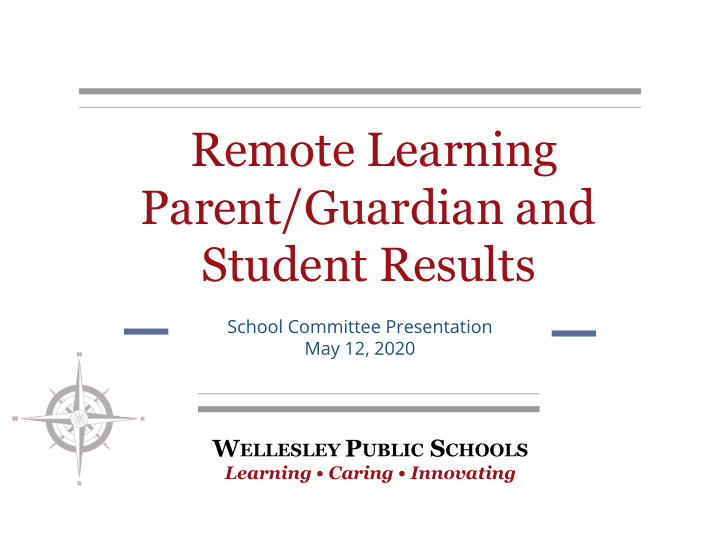



Remote Learning Parent/Guardian and Student Results School Committee Presentation May 12, 2020 W ELLESLEY P UBLIC S CHOOLS Learning • Caring • Innovating
Presentation Overview ● Methods & Participants ● Technology for Remote Learning ● Time on Remote Learning ● Meeting Student Needs ● Overall 2
Methods & Participants 3
Methods ● Google Forms survey ● Parent/Guardian survey in English, Simplified Chinese, and Spanish. Student survey in English. ● Parent/guardian survey distributed via School Messenger emails. Student survey distributed via school email addresses. ● Surveys sent to all WPS parents/guardians and to WPS students grades 7+ on Tuesday, April 28. ● Reminders sent during the week via SEPAC, EL program, and METCO program, as well as by school principals. ● Surveys closed at 3 pm on Monday, May 4. 4
Participants 1,179 parent/guardian responses ● PAWS = 73 (5% of responses) ● Elementary = 723 (61% of responses) ● WMS = 423 (35% of responses) ● WHS = 391 (33% of responses) 529 student responses ● WMS = 229 (44% of responses) ● WHS = 295 (56% of responses) 5
Technology for Remote Learning 6
Most families have enough devices. 7
Most families have reliable internet access. 8
Most students use a device 4 or more hours a day. PARENT/GUARDIAN 9
Technology independence increases dramatically by level. PARENT/GUARDIAN 10
Students with disabilities experience less technology independence. PARENT/GUARDIAN 11
Time on Remote Learning 12
Adults in nearly 60% of families help their children with remote learning 2 or more hours a day. PARENT/GUARDIAN 13
Nearly ¾ found the amount of remote learning time manageable or easily manageable. PARENT/GUARDIAN 14
¾ of secondary students found the amount of remote learning time manageable or easily manageable. COMPARISON 15
Most families are experiencing very little scheduling conflict. PARENT/GUARDIAN 16
Most parents/guardians reported 2-3.5 hours of remote learning while students reported slightly more. Parent/Guardian Survey Student Survey COMPARISON 17
Meeting Student Needs 18
Learning independence increases dramatically between the elementary and middle school levels. PARENT/GUARDIAN 19
Perceptions of rigor and challenge ranged from much too little to the right amount. PARENT/GUARDIAN 20
Students typically perceived rigor and challenge to be the right amount. COMPARISON 21
K-12 parents/guardians typically reported that there was too much disconnection. PARENT/GUARDIAN 22
Students typically reported that there was the right amount of connection. COMPARISON 23
Overall 24
K-12 parents/guardians typically found school and district communication to be adequate or better. PARENT/GUARDIAN 25
WHS students were less likely to find school and district communication to be adequate. COMPARISON 26
Parent/guardian satisfaction with WPS remote learning varied. PARENT/GUARDIAN 27
Students were more satisfied and less dissatisfied than parents/guardians. COMPARISON 28
Parents’/Guardians’ Suggestions for Improvement ● More/longer live sessions with all teachers. ● Higher expectations (e.g., more assignments, richer content, deeper work/projects, increased rigor). Streamlined experience (e.g., single login for all apps, single ● procedure for receiving and submitting assignments, etc.). ● Instruction on new content. ● More connection with teachers and among students. More communication precision and clarity (from district, schools, and ● teachers). ● Content instruction during live sessions. PARENT/GUARDIAN 29
Students’ Suggestions for Improvement ● More live sessions ● Streamlined experience (e.g., single platform, standardized schedule) ● Reduced workload (including flexible expectations, meaningful work, etc.) ● Improved schedule (e.g., no conflicts among live session, more clarity) ● Direct school and district communication to students (vs. through parents) Advance notice of assignments, live meetings, etc. ● ● Content instruction during live sessions ● Follow 30 min assignment guideline ● Fewer required live sessions STUDENT 30
Students’ Reported Remote Learning Benefits ● Flexibility and self-paced learning ● Adequate sleep ● Free time (used to pursue reading, arts, chess, hobbies, volunteering, other topics) ● Less stress ● Continuation of social opportunities ● Continuation of school work ● More time with family ● Continued relationship with teachers STUDENT 31
Requests for Support ● 8 parents/guardians and 7 students submitted contact information, seeking assistance. ○ Technology ○ Food service ○ Reimbursement 32
Next Steps 1. Share survey data widely with key stakeholders. 2. Build on remote learning successes and refine where appropriate: ○ Continue to support teachers as they grow into the remote teaching work. ○ Technology updates (e.g. Seesaw, Google Classroom, Canvas) Consider student feedback at WMS & WHS. ○ 3. Use this experience to inform SY20-21 reopening planning (e.g. devices, professional development). 33
Recommend
More recommend